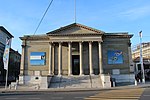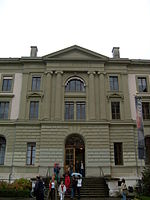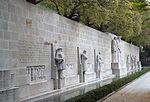Conservatoire de Musique de Genève
1835 establishments in SwitzerlandBaroque architecture in SwitzerlandCultural venues in GenevaEducational institutions established in 1835Music organization stubs ... and 3 more
Music schools in SwitzerlandSchools in GenevaSwitzerland stubs

The Conservatoire de musique de Genève is a music school in Geneva, Switzerland. The Conservatory hosts 2,400 non-professional students. Since 2009, the professional courses have been led by the Geneva University of Music (Haute école de musique de Genève).
Excerpt from the Wikipedia article Conservatoire de Musique de Genève (License: CC BY-SA 3.0, Authors, Images).Conservatoire de Musique de Genève
Place de Neuve, Geneva Cité
Geographical coordinates (GPS) Address Nearby Places Show on map
Geographical coordinates (GPS)
| Latitude | Longitude |
|---|---|
| N 46.2009 ° | E 6.1425 ° |
Address
Conservatoire de Musique de Genève
Place de Neuve 5
1204 Geneva, Cité
Geneva, Switzerland
Open on Google Maps








